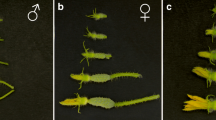Summary
Nasobemia (Ns) is a dominant homeotic mutant ofDrosophila melanogaster which converts parts or all of the antenna to mesothoracic leg.Ns has a temperature sensitive period between 48 and 60 h. The hypothesis thatNs acts during this period and is not required thereafter to maintain the homeotic transformation to leg was tested by removingNs fromNs/+ cells at different stages of development through X-ray induced somatic recombination. The expression of theNs homeotic transformation in recombinant wild type (+/+) cells increased sharply between 48 and 65 h. In clones induced after 65 h the expression of the leg transformation was equal in large and small +/+ clones. We interpret these results as supporting the hypothesis that transient action ofNs between 48 and 65 h switches antennal cells to a clonally stable leg determined state whose maintenance does not require futherNs action.
Similar content being viewed by others
References
Adler P (1978) Mutants of thebithorax complex and determinative states in the thorax ofDrosophila melanogaster. Dev Biol 65:447–461
Becker HJ (1957) Über Röntgenmosaikflecken und Defektmutationen am Auge vonDrosophila und die Entwicklungsphysiologie des Auges. Z Indukt Abstamm Vererbungsl 88:333–373
Capdevila MP, Garcia-Bellido A (1974) Development and genetic analysis ofbithorax phenocopies inDrosophila. Nature (London) 250:500–502
Duncan IW, Kaufman T (1975) Cytogenic analysis of chromosome 3 inDrosophila melanogaster: mapping the proximal portion of the right arm. Genetics 80:733–752
Garcia-Bellido A (1972) Some parameters of mitotic recombination inDrosophila melanogaster. Molec Gen Genetics 115:54–72
Garcia-Bellido A, Dapena J (1974) Induction detection and characterization of cell differentiation mutants inDrosophila. Molec Gen Genet 128:117–130
Gehring WJ (1966) Bildung eines vollständigen Mittelbeins mit Sternopleura in der Antennenregion bei der MutanteNasobemia (Ns) vonDrosophila melanogaster. Arc Julius Klaus-Stift Vererbungsforsch Sozialanthropol Rassenhyg 41:44–54
Gehring WJ (1970) Problems of cell determination and differentiation inDrosophila. In: Hanly E (ed) Problems of Biology RNA in Development. Salt Lake City: University of Utah Press, pp 231–244
Gehring WJ (1976) Developmental genetics ofDrosophila. Ann Rev Genet 10:209–252
Gehring WJ, Nöthiger R (1973) The imaginal discs ofDrosophila. In: Counce SJ, Waddington C (eds) Developmental Systems: Insects. Academic Press, New York, pp 212–219
Gehring WJ, Schubiger G (1975) Expression of homeotic mutations in duplicated and regenerated antennae ofDrosophila melanogaster. J Embryol Exp Morphol 33:459–469
Gloor H (1947) Phanokopie-Versuche mit Äther anDrosophila. Rev Suisse Zool 27:637–712
Grigliatti T, Suzuki DT (1971) Temperature-sensitive mutations inDrosophila melanogaster. VIII. The homeotic mutantss a40a. Proc Natl Acad Sci USA 68:1307–1311
Hadorn E (1966) Dynamics of determination. In: Locke M (ed) Major Problems in Developmental Biology. Academic Press, New York, pp 85–104
Kauffman S (1973) Control circuits for determination and transdetermination. Science 181:310–318
Kauffman S (1975) Control circuits for determination and transdetermination: Interpreting positional information in a binary epigenetic code. In: Cell patterning, Ciba Foundation Symp 29. Elsevier, Amsterdam New York, p 201
Kauffman S, Shymko R, Trabert K (1978) Control of sequential compartment formation inDrosophila. Science 199:259–270
Lindsley DL, Grell EH (1967) Genetic variations ofDrosophila melanogaster. Carnegie Institute Wash Publ 627
Maas A (1948) Über die Auslösbarkeit von Temperatur-Modifikationen während der Embryonalentwicklung vonDrosophila melanogaster, Meigen. Wilhelm Roux's Arch 143:515–572
Ouweneel WJ (1969) Morphology and development ofloboid-ophthalmoptera, a homeotic strain inDrosophila melanogaster. Wilhelm Roux's Arch Entwicklungsmech Organismen 164:1–14
Ouweneel WJ (1976) Developmental genetics of homeosis. Advances in Genetics 18:179–241
Postlethwait JH (1974) Development of the temperature-sensitive homeotic mutantophthalmoptera ofDrosophila melanogaster. Dev Biol 36:212–217
Ripoll A (1980) Effect of terminal aneuploidy on epidermal cell viability inDrosophila melanogaster. Genetics 94:135–152
Sang JH, McDonald JM (1954) Production of phenocopies inDrosophila using salts, particularly sodium metaborate. J Genet 52:392–412
Schubiger G, Alpert GD (1975) Regeneration and duplication events in a temperature sensitive homeotic mutant ofDrosophila melanogaster. Dev Biol 42:292–304
Stepshin VP, Ginter EK (1972) A Study of the homeotic genesAntennopedix andNasobemia inDrosophila melanogaster. Communication III. Influence of temperature on the penetrance and expressivity of theApx andNs genes. Genetika 8:55–62
Suzuki DT (1970) Temperature-sensitive mutations inDrosophila melanogaster. Science 170:695–706
Villee CA (1943) Phenogenetic studies of the homeotic mutants ofDrosophila melanogaster. I. The effects of temperature on the expression of aristapedia. J Exp Zool 93:75–98
Villee CA (1944) Phenogenetic studies of the homeotic mutants ofDrosophila melanogaster. II. The effects of temperature on the expression ofProboscipedia. J Exp Zool 96:85–102
Villee CA (1945) Phenogenetic studies of the homeotic mutants ofDrosophila melanogaster. III. The effects of temperature on the expression ofbithorax-34e. Amer Natur 79:246–258
Waddington CH (1941) The mechanism of the genetic code of development. J Genet 1941, suppl, 310–311
Woolf CM (1949) The effect of temperature treatments on an early developmental period oftumorous head inDrosophila melanogaster. Utah Acad Sci, Arts Lett, Proc 26:139
Author information
Authors and Affiliations
Rights and permissions
About this article
Cite this article
Kauffman, S.A., Ling, E. Timing and heritability of theNasobemia transformation inDrosophila . Wilhelm Roux' Archiv 189, 147–153 (1980). https://doi.org/10.1007/BF00848503
Received:
Accepted:
Issue Date:
DOI: https://doi.org/10.1007/BF00848503




